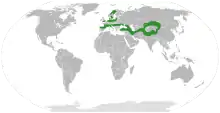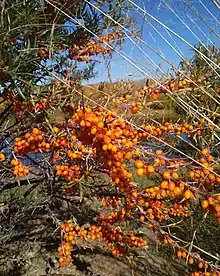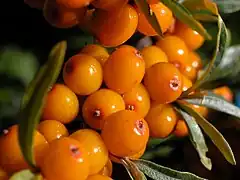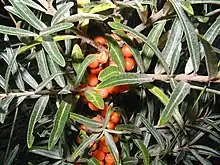Hippophae
Hippophae is the genus of sea buckthorns, deciduous shrubs in the family Elaeagnaceae. The name sea buckthorn may be hyphenated[1] to avoid confusion with the unrelated true buckthorns (Rhamnus, family Rhamnaceae). It is also referred to as sandthorn, sallowthorn,[2] or seaberry.[3] It produces orange-yellow berries, which have been used over centuries as food, traditional medicine, and skin treatment in Mongolia, Ladakh, Russia, Ukraine, and northern Europe, which are its origin regions.[4]
| Hippophae | |
|---|---|
.JPG.webp) | |
| Common sea buckthorn shrub in the Netherlands | |
| Scientific classification | |
| Kingdom: | Plantae |
| Clade: | Tracheophytes |
| Clade: | Angiosperms |
| Clade: | Eudicots |
| Clade: | Rosids |
| Order: | Rosales |
| Family: | Elaeagnaceae |
| Genus: | Hippophae L. |
| Type species | |
| Hippophae rhamnoides | |
| Species | |
|
See text | |
 | |
| Synonyms | |
| |
They are exceptionally hardy plants, able to withstand winter temperatures as low as −43 °C (−45 °F).[4] Because Hippophae species develop an aggressive and extensive root system, they are planted to inhibit soil erosion and used in land reclamation for their nitrogen fixing properties, wildlife habitat, and soil enrichment.[5] Hippophae berries and leaves are manufactured into various human and animal food and skincare products.[4]
Description
The shrubs reach 0.5–6 m (1 ft 8 in – 19 ft 8 in) tall, rarely up to 10 metres (33 ft) in central Asia. The leaf arrangement can be alternate or opposite.[6]
- Hippophae goniocarpa grows in mountainous regions in Nepal and China on mountain slopes, river banks, flood lands and valley terraces. The growth altitude is typically between 2650 and 3700 m. The species is divided into two distinct subspecies, H. goniocarpa subsp. litangensis and H. goniocarpa subsp. goniocarpa. H. goniocarpa subsp. litangensis differs from the typical subspecies by the young branchlets and the lower surface of leaves.[7] The Latin specific epithet goniocarpa refers to goniocarpus -a -um with angular fruits.[8]
- Hippophae gyantsensis
- Hippophae litangensis
- Hippophae neurocarpa
- Hippophae rhamnoides: Common sea buckthorn has dense and stiff branches, and are very thorny. The leaves are a distinct pale silvery-green, lanceolate, 3–8 cm (1–3 in) long, and less than 7 mm (1⁄4 in) broad. It is dioecious, with separate male and female plants. The male produces brownish flowers which produce wind-distributed pollen. The female plants produce orange berries 6–9 mm (1⁄4–3⁄8 in) in diameter, soft, juicy, and rich in oils. The roots distribute rapidly and extensively, providing a nonleguminous nitrogen fixation role in surrounding soils.
- Hippophae salicifolia (willow-leaved sea buckthorn) is restricted to the Himalayas, to the south of the common sea buckthorn, growing at high altitudes in dry valleys; it differs from H. rhamnoides in having broader (to 10 mm (3⁄8 in)) and greener (less silvery) leaves, and yellow berries. A wild variant occurs in the same area, but at even higher altitudes in the alpine zone. It is a low shrub not growing taller than 1 m (3 ft 3 in) with small leaves 1–3 cm (1⁄2–1+1⁄4 in) long.
- Hippophae tibetana
- Hippophae × goniocarpa Y.S.Lian et al. ex Swenson & Bartish
Taxonomy and name
Hippophae is a small genus of Elaeagnaceae having a terminal taxon with seven species recognized, as of 2002.[6] Hippophae rhamnoides is a highly variable species with eight subspecies.[6]
In ancient times, leaves and young branches from sea buckthorn were supposedly fed as a remedy to horses to support weight gain and appearance of the coat, leading to the name of the genus, Hippophae derived from the Greek hippo (horse), and phaos (shining).[4]
Distribution

Hippophae rhamnoides, the common sea buckthorn, is the most widespread of the species in the genus, with the ranges of its eight subspecies extending from the Atlantic coasts of Europe across to northwestern Mongolia, northwestern China and Northern Pakistan.[4][9] In western Europe, it is largely confined to sea coasts where salt spray off the sea prevents other larger plants from outcompeting it. In central Asia, it is more widespread in dry semi-desert sites where other plants cannot survive the dry conditions.
In central Europe and Asia, it also occurs as a sub-alpine shrub above the tree line in mountains, and other sunny areas such as river banks where it has been used to stabilize erosion.[4] They are tolerant of salt in the air and soil, but demand full sunlight for good growth and do not tolerate shady conditions near larger trees. They typically grow in dry, sandy areas.
More than 90% or about 1,500,000 ha (3,700,000 acres) of the world's natural sea buckthorn habitat is found in China, India, Pakistan, Mongolia, Russia, northern Europe, Ukraine, and Canada, where the plant is used for soil, water and wildlife conservation, anti-desertification purposes, and consumer products.[4]
Sea buckthorn USDA hardiness zones are about 3 through 7.[4]
Varieties
During the Cold War, Russian and East German horticulturists developed new varieties with greater nutritional value, larger berries, different ripening months and branches that are easier to harvest. Over the past 20 years, experimental crops have been grown in the United States, one in Nevada and one in Arizona, and in several provinces of Canada.[10]
Genetics
A study of nuclear ribosomal internal transcribed spacer sequence data[11] showed that the genus can be divided into three clades:
- H. tibetana
- H. rhamnoides with the exception of H. rhamnoides ssp. gyantsensis (=H. gyantsensis)
- remaining species
A study using chloroplast sequences and morphology,[9] however, recovered only two clades:
- H. tibetana, H. gyantsensis, H. salicifolia, H. neurocarpa
- H. rhamnoides
Natural history
The fruit is an important winter food resource for some birds, notably fieldfares.
Leaves are eaten by the larva of the coastal race of the ash pug moth and by larvae of other Lepidoptera, including brown-tail, dun-bar, emperor moth, mottled umber, and Coleophora elaeagnisella.
Uses

Products
Sea buckthorn berries are edible and nutritious, though astringent, sour, and oily[12] unless bletted (frosted to reduce the astringency) and/or mixed as a drink with sweeter substances such as apple or grape juice. Additionally, malolactic fermentation of sea buckthorn juice reduces sourness, enhancing its sensory properties. The mechanism behind this change is transformation of malic acid into lactic acid in microbial metabolism.[13]
When the berries are pressed, the resulting sea buckthorn juice separates into three layers: on top is a thick, orange cream; in the middle, a layer containing sea buckthorn's characteristic high content of saturated and polyunsaturated fats; and the bottom layer is sediment and juice.[4][14] The upper two layers contain fat sources applicable for cosmetic purposes and can be processed for skin creams and liniments, whereas the bottom layer can be used for edible products such as syrup.[14]
Besides juice, sea buckthorn fruit can be used to make pies, jams, lotions, teas, fruit wines, and liquors.[4] The juice or pulp has other potential applications in foods, beverages, or cosmetics products such as shower gel.[4] Fruit drinks were among the earliest sea buckthorn products developed in China. Sea buckthorn-based juice is common in Germany and Scandinavian countries. It provides a beverage rich in vitamin C and carotenoids.[4] Sea buckthorn berries are also used to produce rich orange-coloured ice-cream, with a melon-type taste and hints of citrus.[15][16]
For its troops confronting low winter temperatures (see Siachen), India's Defence Research and Development Organisation established a factory in Leh to manufacture a multivitamin herbal beverage based on sea buckthorn juice.[17]
The seed and pulp oils have nutritional properties that vary under different processing methods.[18] Sea buckthorn oils are used as a source for ingredients in several commercially available cosmetic products and nutritional supplements.[4]
Landscape uses
Sea buckthorn may be used as a landscaping shrub with an aggressive basal shoot system used for barrier hedges and windbreaks, and to stabilize riverbanks and steep slopes.[4] They have value in northern climates for their landscape qualities, as the colorful berry clusters are retained through winter.[4][5][19] Branches may be used by florists for designing ornaments.
In northwestern China, sea buckthorn shrubs have been planted on the bottoms of dry riverbeds to increase water retention of the soil, thus decreasing sediment loss.[4] Because of increased moisture conservation of the soil and nitrogen-fixing capabilities of sea buckthorn, vegetation levels have increased in areas where sea buckthorn have been planted.[20][21] Sea buckthorn was once distributed free of charge to Canadian prairie farmers by PFRA to be used in shelterbelts.[22]
Folk medicine and research
Sea buckthorn has been used over centuries in traditional medicine.[4] Although sea buckthorn fruit extracts are under preliminary research for their pharmacological effects, there is no high-quality clinical evidence for the ability of Hippophae products to lower the risk of human diseases.[23] As of 2022, no sea buckthorn products are approved as prescription drugs by any national regulatory agency.[23]
Berry oil from seeds or fruit pulp, either taken orally as a dietary supplement or applied topically, is believed to be a skin softener or medicine, but there is inadequate clinical evidence of its effectiveness.[23] There have been no systematic studies of toxicity and safety for any Hippophae product.[23]
Organizations
The International Seabuckthorn Association, formerly the International Center for Research and Training on Seabuckthorn (ICRTS), was formed jointly in 1988 by the China Research and Training Center on Seabuckthorn, the Seabuckthorn Office of the Yellow River Water Commission, and the Shaanxi Seabuckthorn Development Office. From 1995 to 2000, ICRTS published the research journal, Hippophae, which appears to be no longer active.
In 2005 - 2007, the "EAN-Seabuck" network between European Union states, China, Russia and New Independent States was funded by the European Commission to promote sustainable crop and consumer product development.[24]
In Mongolia, there is an active National Association of Seabuckthorn Cultivators and Producers.[25]
See also
- Sea buckthorn oil
- Wolfberry, a native Asian plant occasionally mistaken for sea buckthorn
References
- "Sea buckthorn". The Wildlife Trusts. Archived from the original on 2015-06-12. Retrieved 23 July 2013.
- "Hippophae rhamnoides". Germplasm Resources Information Network. Agricultural Research Service, United States Department of Agriculture. Retrieved 12 December 2017.
- "PLANTS Profile for Hippophae rhamnoides (seaberry)". United States Department of Agriculture. Retrieved 2007-10-08.
- Li TSC (2002). Janick J, Whipkey A (eds.). Product development of sea buckthorn (PDF). pp. 393–8. Retrieved 16 May 2014.
{{cite book}}:|work=ignored (help) - Li TS, Oliver A (May 2001). "Sea buckthorn factsheet" (PDF). British Columbia Ministry of Agriculture, Food and Fisheries. Archived from the original (PDF) on 2008-05-28. Retrieved 26 September 2019.
- Swenson, Ulf; Bartish, Igor V. (2002). "Taxonomic synopsis of Hippophae (Elaeagnaceae)". Nordic Journal of Botany. 22 (3): 369–374. doi:10.1111/j.1756-1051.2002.tb01386.x.
- Yongshan, Lian; Xuelin, Chen; Hong, Lian (2003). "Taxonomy of seabuckthorn (Hippophae L.)". Seabuckthorn (Hippophae L.): A Multipurpose Wonder Plant, Vol. I. New Delhi, India: Indus Publishing Company. pp. 35–46. ISBN 978-81-7387-156-6.
- D. Gledhill The Names of Plants, p. 192, at Google Books
- Bartish, Igor V.; Jeppsson, Niklas; Nybom, Hilde; Swenson, Ulf (2002). "Phylogeny of Hippophae (Elaeagnaceae) inferred from parsimony analysis of chloroplast DNA and morphology". Systematic Botany. 2 (1): 41–54. doi:10.1043/0363-6445-27.1.41 (inactive 1 August 2023). JSTOR 3093894.
{{cite journal}}: CS1 maint: DOI inactive as of August 2023 (link) - Agriculture and Agri-Food Canada, Prairie Farm Rehabilitation Administration Center, Sea-buckthorn: A promising multi-purpose crop for Saskatchewan, January 2008
- Sun, K.; Chen, X.; Ma, R.; Li, C.; Wang, Q.; Ge, S. (2002). "Molecular phylogenetics of Hippophae L. (Elaeagnaceae) based on the internal transcribed spacer (ITS) sequences of nrDNA". Plant Systematics and Evolution. 235: 121–134. doi:10.1007/s00606-002-0206-0. S2CID 27312983.
- Tiitinen, Katja M.; Hakala, Mari A.; Kallio, Heikki P. (March 2005). "Quality components of sea buckthorn (Hippophaë rhamnoides) varieties". Journal of Agricultural and Food Chemistry. 53 (5): 1692–1699. doi:10.1021/jf0484125. ISSN 0021-8561. PMID 15740060.
- Tiitinen, Katja M.; Vahvaselkä, Marjatta; Hakala, Mari; Laakso, Simo; Kallio, Heikki (December 2005). "Malolactic fermentation in sea buckthorn (Hippophaë rhamnoides L.) juice processing". European Food Research and Technology. 222 (5–6): 686–691. doi:10.1007/s00217-005-0163-2. ISSN 1438-2377. S2CID 84226673.
- Seglina, D.; et al. (2006). "The effect of processing on the composition of sea buckthorn juice" (PDF). J Fruit Ornamental Plant Res. 14: 257–63. Archived from the original (PDF) on 2008-05-28. Retrieved 2007-09-12. (Suppl 2)
- "Sea Buckthorn Ice Cream "Autumn kiss"". Food Recipes Hub. 2019. Retrieved 1 August 2022.
- "Sea Buckthorn Ice". Eis Perfecto. Retrieved 1 August 2022.
- "Leh berries to dot Himalayan deserts by 2020". Archived from the original on 8 October 2013. Retrieved 15 August 2012.
- Cenkowski S; et al. (2006). "Quality of extracted sea buckthorn seed and pulp oil". Canadian Biosystems Engineering. 48 (3): 9–16.
- Kam, B.; N. Bryan (2003). The Prairie Winterscape: Creative Gardening for the Forgotten Season. Fifth House Ltd. pp. 108–10. ISBN 978-1-894856-08-9.
- Zhang, Kang; Xu, Mengzhen; Wang, Zhaoyin (2009). "Study on reforestation with seabuckthorn in the Pisha Sandstone area". Journal of Hydro-environment Research. 3 (2): 77–84. doi:10.1016/j.jher.2009.06.001. ISSN 1570-6443.
- Yang, Fang-She; Bi, Ci-Fen; Cao, Ming-Ming; Li, Huai-En; Wang, Xin-Hong; Wu, Wei (2014). "Simulation of sediment retention effects of the double seabuckthorn plant flexible dams in the Pisha Sandstone area of China". Ecological Engineering. 71: 21–31. doi:10.1016/j.ecoleng.2014.07.050. ISSN 0925-8574.
- "Prairie Shelterbelt Program:Application for Trees" (PDF). Agriculture and Agri-Food Canada. 2008. Archived from the original (PDF) on 21 October 2013.
- "Sea buckthorn". Drugs.com. 19 December 2022. Retrieved 10 January 2023.
- "Final Report Summary - EAN-SEABUCK". CORDIS - EU Research results. European Commission. Retrieved 21 August 2020.
- Ichinkhorloo (24 January 2017). "Result of GAP analysis beyond the organic Seabuckthorn value chain". Retrieved 21 August 2020.
Further reading
- Beveridge, Thomas H. J.; Li, Thomas S. C. (2003). Sea buckthorn (Hippophae rhamnoides L.) production and utilization. Ottawa: NRC Research Press. ISBN 978-0-660-19007-5. Archived from the original on 2007-12-25.
- Todd, J. Introduction to sea-buckthorn, Ontario Ministry of Food, Agriculture and Rural Affairs, February, 2006
